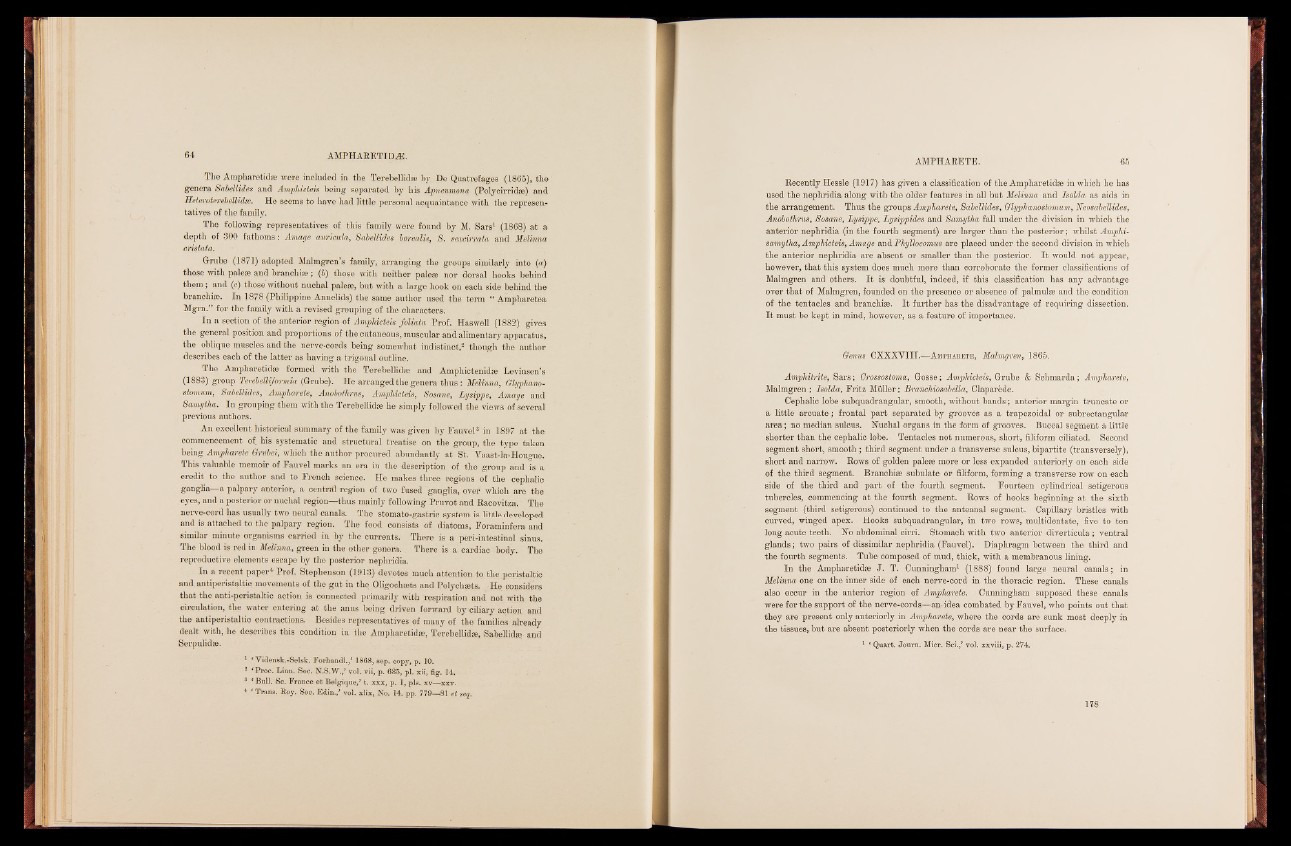
The Ampharetidse were included in the Terebellidse by. De Quatrefages (1865), the
genera Sabellides and Amphieteis being separated by his Apneumona (Polycirridae) and
Heteroterebellidse. He seems to have had little personal acquaintance with the representatives
of the family.
The following representatives of this family were found by M, Bars1 (1868) at a
depth of 300 fathoms: Amage auvieulo, Sabellides borealis, S. sexcirrata and Melinna
mistata.
Grube_ (1871) adopted Malmgren’s family, arranging the groups similarly into (a)
those with palete and branchise; (b) those with neither palese nor dorsal hooks behind
them ; and (c) those without nuchal palem, but with a large hook on each side behind the
branchise. Ip 1878 (Philippine Apnehde) the same author used the term “ Ampharetea
Mgrn.” for the family with a revised grouping of the characters.
In a section of the anterior region of Amphieteis foliata Prof. Caswell (§lp) gives
the general position and proportions of the cutaneous, muscular and alimentary apparatus,
the oblique muscles and the nerve-cords being somewhat indistinct,1 2 * 4 though the author
describes each of the latter as having a trigonal outline.
The Ampharetidse formed with the Terebellidse and Amphictenidse Levinsen’s
(1883) group TerebelUformia (Grube). He arranged the genera thus : Meliwna, Glyphano-
stomum, Sabellides, Ampharete, Anobotli'rus, Amphieteis, Sosane, Lysippe, Amage and
Sa/mytha. In grouping them with the Terebellidaa he simply followed the views of several
previous authors.
An excellent historical summary of the family was given by Fauvel8 in 1897 at the
commencement of. his systematic and structural treatise on the group, the type taken
being Ampharete Grubei, which the author procured abundantly at St. Yaast-la-Ho'ugue.
This valuable memoir of Pauvel marks an era in the description, of the group and is a
credit to the author and to French science. He makes three regions of the cephalic
ganglia—a palpary anterior, a central-region of two fused “ganglia, over: which are the
eyes, and a posterior or nuchal region—thus mainly following Pruvot and Racovitza. The
nerve-cord has usually two neural canals. The stomato-gastric system is little developed
and is attached to the palpary region. The fopd1 consists of diatoms, Foraminfera and
similar minute organisms carried in by the currents. There is a peri-intestinal sinus.
The blood is red in Melinna, green in the other genera. There is a cardiac: body. The
reproductive elements escape by the posterior nephridia.
In a recent paper* Prof. Stephenson (1.913) devotes much attention to. the peristaltic
and antiperistaltic movements of the gut in the Oligochaets and Polychaets. He considers
that the anti.peristaltic aotion is connected primarily with respiration and not with the
circulation, the water entering at the anus being driven forward by ciliary action and
the antiperistaltio contractions. Besides representatives of many of the'families already
dealt with, he describes this condition in the Ampharetidas, Terebellidse, Sabellidm and
Serpulidse.
1 ‘ Yidensk.-Selsk. Forhandl./ 1868, sep. copy, p. 10.
2 'Proc. Linn. Soc. N.SVW./ vol. vii, p. 635, pi. xii, fig. 14.
I ‘ Bull. Sc. France et Belgique,* t. xxx, p. 1, pis. xv—xxv.
4 ‘ Trans. Roy. Soc. Edin./ vol. xlix, No. 14. pp. 779—-81 et seq.
Recently Hessle (1917) has given a classification of the Ampharetidaa in which he has
used the nephridia along with the older features in all but Melinna and Isolda as aids in
the arrangement. Thus the groups Ampharete, Sabellides, Qlyphanostomum, Neosabellides,
Andbothras, Sosane, Lysippe, Lysippides and Samytha fall under the division in which the
anterior nephridia (in the fourth segment) are larger than the posterior; whilst Amphi-
samytha, Amphieteis, Amage and Phyllocomus are placed under the second division in which
the anterior nephridia are absent or smaller than the posterior. It would not appear,
however, that this system does much more than corroborate the former classifications of
Malmgren and others. It is doubtful, indeed, if this classification has any advantage
over that of Malmgren, founded on the presence or absence of palmulas and the condition
of the tentacles and branchiae. It further has the disadvantage of requiring dissection.
It must be kept in mind, however, as a feature of importance.
Genus CXXXVIII.—Ampharete, Malmgren, 1865.
Amphitrite, Sars ; Grossostoma, Grosse ; Amphieteis, Grrube & Schmarda ; Ampharete,
Malmgren ; Isolda, Fritz Müller ; Branchiosabella, Claparède.
Cephalic lobe subquadrangular, smooth, without bands ; anterior margin truncate or
a little arcuate ; frontal part separated by grooves as a trapezoidal or subrectangular
area ; no median sulcus. Nuchal organs in the form of grooves. Buccal segment a little
shorter than the cephalic lobe. Tentacles not numerous, short, filiform ciliated. Second
segment short, smooth ; third segment under a transverse sulcus, bipartite (transversely),
short and narrow. Rows of golden paleæ more or less expanded anteriorly on each side
of the third segment. Branchiae subulate or filiform, forming a transverse row on each
side of the third and part of the fourth, segment. Fourteen cylindrical setigerous
tubercles, commencing at the fourth segment. Rows of hooks beginning at the sixth
segment (third setigerous) continued to the anteanal segment. Capillary bristles with
curved, winged apex. Hooks subquadrangular, in two rows, multidentate, five to ten
long acute teeth. No abdominal cirri. Stomach with two anterior diverticula ; ventral
glands ; two pairs of dissimilar nephridia (Fauvel). Diaphragm between the third and
the fourth segments. Tube composed of mud, thick, with a membranous lining.
In the Ampharetidæ J. T. Cunningham1 (1888) found large neural canals ; in
Melinna one on the inner side of each nerve-cord in the thoracic region. These canals
also occur in the anterior region of Ampharete. Cunningham supposed these canals
were for the support of the nerve-cords—anridea combated by Fauvel, who points out that
they are present only anteriorly in Ampha?'ete, where the cords are sunk most deeply in
the tissues, but are absent posteriorly when the cords are near the surface.
1 ‘ Quart. Journ. Micr. Sci./ vol. xxviii, p. 274.